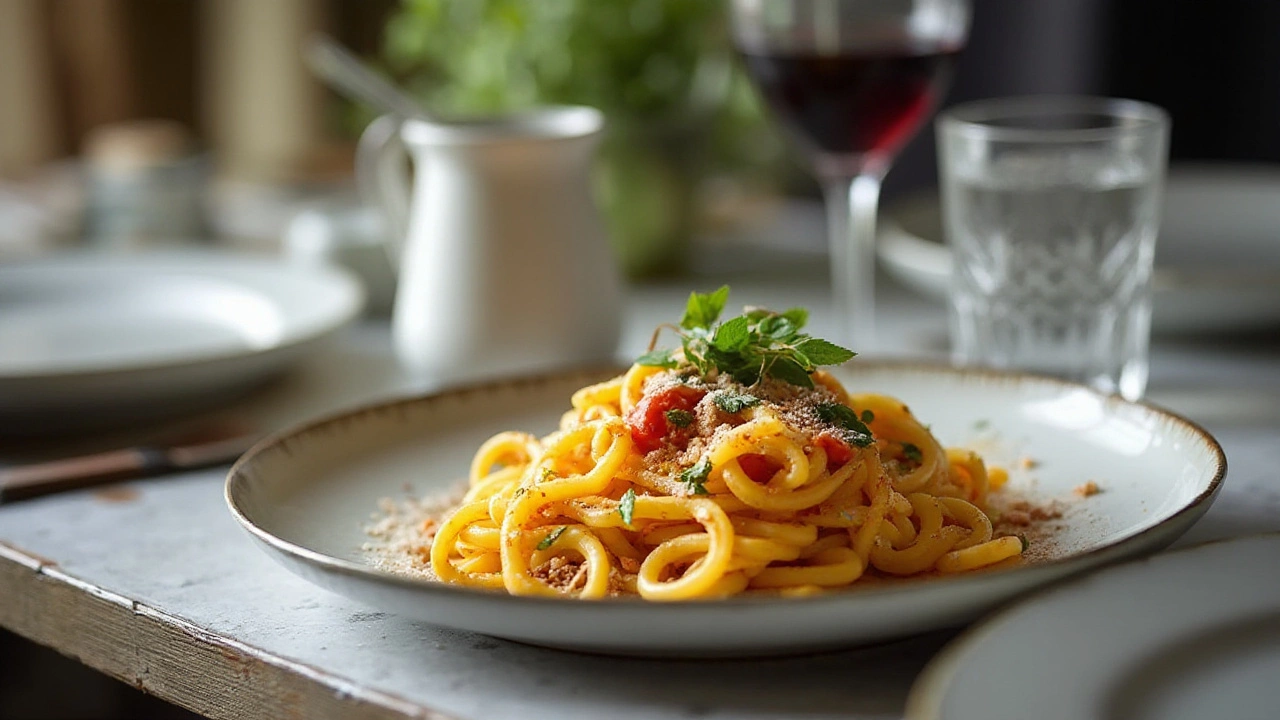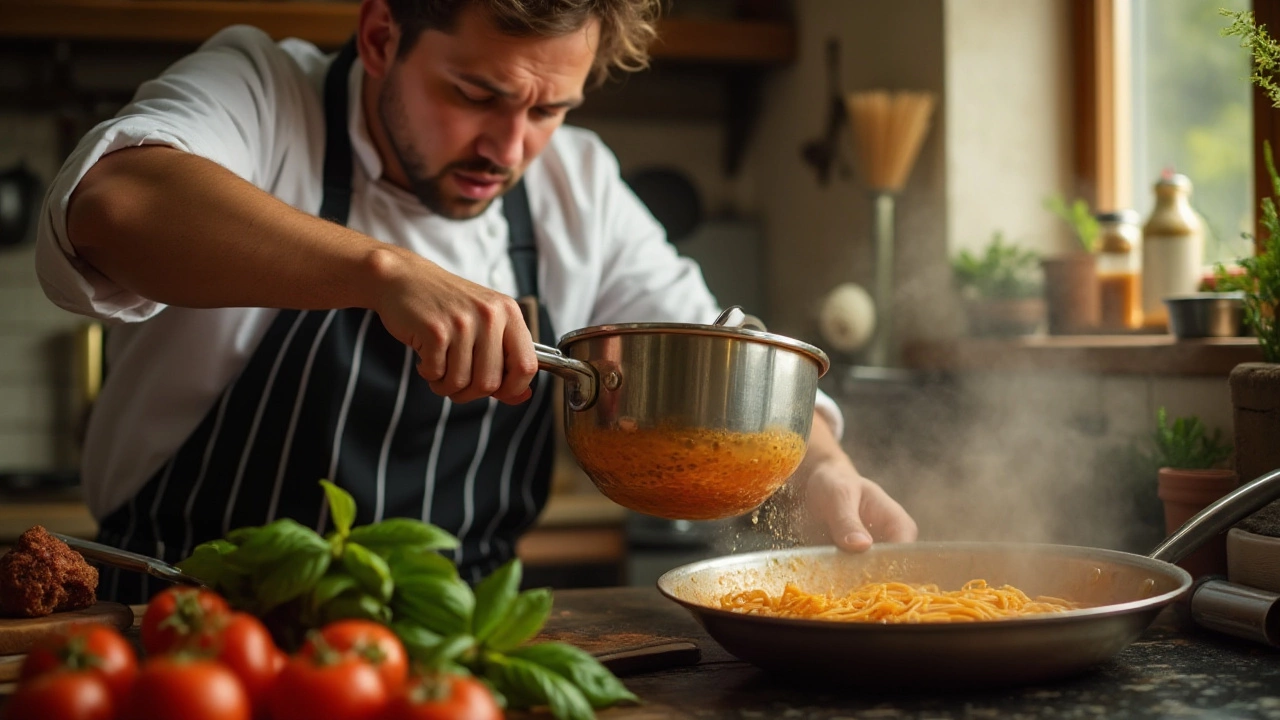Pasta water, often dubbed as 'liquid gold' by culinary enthusiasts, is an unsung hero in the kitchen. Many of us pour it down the drain without a second thought, unaware of its hidden potential. In reality, this starchy liquid can bring an amazing depth of flavor and texture to your dishes, elevating them from good to great.
Join us as we explore why pasta water is so valuable and the myriad of ways it can be used to enhance your culinary creations. Whether you’re a seasoned chef or someone who simply loves good food, understanding the magic of pasta water can revolutionize your cooking adventures. Let’s dive into the sticky, flavorful world of pasta water and unleash its full potential in your kitchen.
- The Science of Starch
- Perfect Pasta Sauces
- Boosting Flavors with Pasta Water
- Creative Uses Beyond Pasta
The Science of Starch
Starch holds a fascinating place in the culinary world, playing an often-overlooked but pivotal role in many cooking processes. When you cook pasta, the starches in the flour expand and dissolve in the simmering water, creating a starchy brew that is anything but waste. This pasta water becomes rich with carbohydrates that are released from the pasta, creating a slightly cloudy liquid that, though it may look unassuming, can work wonders in your kitchen. The starch content in this water is crucial for emulsifying sauces, which means it helps fats and acids combine smoothly, giving rise to that luxurious, glossy texture we often crave in a perfect pasta dish.
Consider a simple aglio e olio, a minimalist pasta dish that relies heavily on a few simple ingredients: olive oil, garlic, and chili flakes. Yet, the magic truly happens when a ladle or two of starchy pasta water is added to the pan. This helps the oil cling better to each spaghetti strand, avoiding a greasy pool at the bottom of your bowl. Scientific studies have shown that emulsification is the key to such culinary tricks. It also aligns perfectly with what culinary expert Harold McGee notes in his books: “Starches are invaluable for bringing body and a rounded mouthfeel to foods.” The pasta's own starch helps create a dish that’s cohesive and satisfying, without extra cream or cheese.
Diving deeper, it's essential to understand that different types of pasta release varying levels of starch. Fresh pasta, often made with eggs, tends to start with less starch than its dried counterpart, which is constructed from just semolina flour and water. This means dried pasta generally releases more starch into the cooking water. Intriguingly, researchers have outlined that this starchy liquid can play a role beyond pasta—impacting the creation of soups, stews, and even bread if you're adventurous! Other studies reveal that saving pasta water can contribute to reducing food waste, a significant consideration given our global discourse on sustainability.
"Understanding how ingredients interact can free you to make dishes on the fly," notes Harold McGee, a respected author in food science.
The adaptability of pasta water in cooking also highlights the intimacy of the culinary process—the ability to tweak, mold, and personalize dishes to suit one's taste. With countless pasta meals sprinkled across Italian gastronomy—each distinguished by the type of starch involved—this liquid gold serves as a whisper of Italy's culinary tradition, binding everything in the mix. In soup-based dishes, chefs might add a touch of this water to enhance the broth's depth, silently relying on the starch to up the ante without overcrowding the pot with extra ingredients.
Additionally, a thorough examination of the starch sediment chart reveals that an optimal pasta cooking time for starchy water collection is between 6 and 8 minutes. This handy table—illustrated below—compares starchy concentration levels and their effectivity in emulsification.
| Cooking Time (minutes) | Starch Concentration | Best Use |
|---|---|---|
| 6 | Moderate | Light sauces |
| 8 | High | Thick, emulsified sauces |
This connection between science and cooking reveals not just a way to enhance our meals but also reminds us how meticulous techniques passed down through generations often stem from basic culinary science concepts. By appreciating its role, we're not merely making a plate of pasta—we're mastering a skill cherished by countless food lovers, grounded in the harmony of both taste and tradition.

Perfect Pasta Sauces
Creating a perfect pasta sauce is an art that hinges on a critical, often neglected component: pasta water. This cloudy elixir, which results from cooking pasta, is brimming with starch extracted from the noodles. It holds the magical ability to transform basic sauces into silky, cohesive masterpieces, creating a delightful dining experience. The starchy nature of pasta water is effective in thickening sauces seamlessly, allowing them to cling lovingly to the pasta, ensuring every bite is flavorful and rich. This is no ordinary kitchen hack; it is a time-honored technique employed by chefs in traditional Italian cuisine, renowned for its simplicity and impact.
In many traditional recipes, a portion of the pasta water is reserved prior to draining your noodles. After you've assembled your sauce, whether it’s a classic tomato, velvety Alfredo, or noble pesto, you reintroduce the reserved liquid gradually. This method provides the necessary consistency and enhances the flavor profile of the dish extensively. It’s worth mentioning that adding pasta water during the final stages of sauce preparation binds the fat of butter or oil with the water in the sauce, resulting in an emulsion that is impossibly smooth. A well-known chef once remarked, "The heart of any exquisite pasta dish beats with the rhythm of pasta water," highlighting its unrivaled importance in crafting exceptional meals.
Pasta water offers flexibility across a vast array of sauces, including creamy versions that tend to separate otherwise. For instance, in preparations of a classic Carbonara, a notorious challenge is the preparation of a sauce that is not too thick, nor too thin, and pasta water is the definitive solution. When combined with the egg and cheese mixture, the residual heat from the pasta, along with the binding power of pasta water, melds everything beautifully, avoiding the dreaded scramble. Similarly, for a lighter yet flavorful pomodoro sauce, the addition of pasta water enriches the tomatoes, marrying all elements through its molten, starch-infused magic.
Pasta water isn’t just confined to these traditional uses; it fosters creativity as well. Suppose you have an olive oil based sauce infused with herbs; the starch thickens the oil and disperses the flavors vividly throughout the pasta. It essentially enables your ingredients to sing, offering up their fullest potential without overtaking the charms of fresh, al dente noodles beneath. The beauty of pasta water is that it’s a versatile ally in the culinary journey, transforming a run-of-the-mill sauce into something truly spectacular. With each experimentation, pasta water reveals new depths of artistry in cooking, guiding us to become more intuitive and thoughtful cooks.

Boosting Flavors with Pasta Water
When it comes to enhancing flavors in your kitchen creations, few things are as unassuming yet powerful as reserved pasta water. This cloudy, seemingly unimportant liquid is packed with starch and salt, giving it incredible potential to enrich a myriad of dishes. The secret lies in its ability to act as a binder and enhancer, creating a silky, cohesive texture and amplifying the essence of the ingredients.
Pasta water acts as a natural thickening agent, due to the starch it absorbs from the cooking pasta. As you finish off your pasta dish, adding a ladle of this 'liquid gold' can marry the sauce and pasta seamlessly, ensuring every noodle is perfectly coated and flavored. This technique doesn't end with classic spaghetti; it can elevate any dish where liquid consistency is key – from risottos to soups, providing both thickness and depth of flavor without compromising its taste balance.
A study published in the Journal of Culinary Science & Technology emphasizes the starch's role in enhancing flavors. According to food scientists, starch molecules can capture and hold umami compounds—core flavor enhancers found in foods like tomatoes, mushrooms, and cheeses. As a practical example, consider how an Alfredo sauce can benefit from this natural thickener. By adding pasta water, its lush creaminess is perfectly synchronized with the pasta, accentuating its decadent cheese and butter flavors without diluting them. Chef extraordinaire, Massimo Bottura, once said,
'Using your pasta water is like upgrading your dish's motherboard. It's an essential connector that brings all elements into harmony.'
If you're feeling a bit experimental, try incorporating pasta water into your recipes beyond traditional pasta dishes. When making a stir-fry, add pasta water to your sauce to pack an extra punch of flavor and improve sauce adherence. Or, use it as a base for poaching fish or vegetables, carrying additional seasonings directly into the food. The adaptability of pasta water isn't limitless, but it surely stretches quite far when used creatively. Consider the nutritional benefit as well; while the water mainly consists of carbohydrates from the starch, it’s low in calories, offering an impactful yet lower-calorie option to enrich meals than heavy creams or full-fat additions.
The possibilities with pasta water are vast and exciting. The key is experimenting and understanding its properties. Observe how different pasta types release varying starch levels, or how the saltiness enhances the complex flavors in your sauces. Through trial and error, you can establish your cooking routine and discover new, exciting nuances in any dish you prepare. This transformation from waste to resourceful ingredient is the quintessence of a knowledgeable cook harnessing every opportunity to make their dishes shine.

Creative Uses Beyond Pasta
When it comes to the pasta water, its use extends far beyond simply tossing it with penne or spaghetti. This briny byproduct can turn ordinary meals into extraordinary delights across various culinary ventures. First and foremost, its starchy content makes it an excellent base for soups and broths. Imagine crafting a minestrone or Italian wedding soup with the rich, silky consistency that only pasta water can provide. Its subtle flavor and thickening ability add a unique twist that can elevate even the simplest of soups. With its capacity to help infuse seasonings more evenly, many chefs swear by using it in their homemade broths, giving their liquid bases a hearty, genuine Italian character.
Another surprisingly effective use of pasta water involves baking. Incorporating this ingredient into your bread or pizza dough can infuse a distinct depth and elasticity that enhances the texture remarkably. Many traditional Italian bakers embrace this secret, claiming it's responsible for the chewier, fluffier loaves Italians are known for. In the realm of baking, this simple addition may just revolutionize your approach, creating taste sensations right from your humble kitchen.
Yet, its capabilities stretch even further; pasta water is a secret weapon in your gardening toolkit. Believe it or not, utilizing cooled pasta water as a fertilizer can enrich your plants with valuable nutrients. The minerals released during cooking, primarily starch from the pasta, serve as a natural fertilizer, enhancing plant growth in an organic manner. This method, praised by horticulturists, not only promotes plant vitality but also contributes to a more sustainable kitchen-to-garden ecosystem.
For those who enjoy the fizz of carbonated beverages, consider mixing pasta water into your artisan cocktail repertoire. Its unique salinity complements certain flavors beautifully, adding an unexpected sparkle to your culinary drink adventures. When combined with citrus notes, think of refreshing twists to classic gin or tequila concoctions. Some innovative mixologists use pasta water to balance the sweet and sour elements, crafting drinks that start conversations at any dinner party.
And it doesn't stop there. Chefs love whipping up dips with a splash of pasta water to achieve a smoother consistency. Instead of the usual water or broth, adding a dash of this starchy elixir can transform guacamole, hummus, or bean dips, turning them into creamy, flavorful companions for your appetizers. For those more inclined toward dairy delights, pasta water offers a secret sauce upgrade; a splash can take your cheese fondue or Alfredo sauce to new levels of richness and taste. As food journalist Harold McGee once said,
"In the simplest acts of the kitchen lie the most extraordinary flavors."

